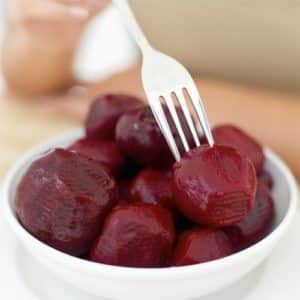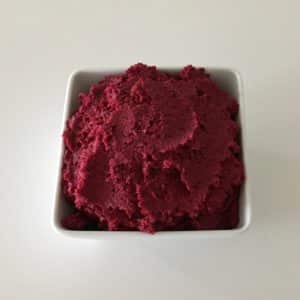In what form and how to freeze beets for the winter in the freezer: general rules and useful tips
Beets contain many vitamins, amino acids and minerals. It occupies one of the first places in providing the body with magnesium, sodium, chlorine, phosphorus and calcium. Its root vegetables contain large amounts of iodine. Therefore, beets must be included in the diet, especially in the winter season.
Freezing is one of the most effective ways to prepare vegetables for the winter. Frozen vegetables retain more vitamins and nutrients than those stored in cool rooms and cellars. But in order for frozen foods to remain healthy, you need to take into account some of the nuances of preparation. Let's look at how to freeze beets for the winter in the freezer.
Is it possible to freeze beets for the winter at home?

Beets are harvested for future use in various ways. One of them is freezing.
Advantages of this method:
- The freezing process takes less time and effort than conservation.
- The result is a semi-finished product that will save time when preparing dishes.
- Almost all beneficial substances are preserved in frozen root vegetables.
- You will be confident in the quality of the frozen product, unlike store-bought mixtures.
Subtleties of the process
Before freezing, prepare the container. It must be clean and dry. Plastic disposable containers or bags (special for freezing or regular packaging) are suitable.
Since the root vegetable loses its beneficial properties when re-frozen, it is advisable to freeze it in small portions, which are required for preparing the dish.
Root vegetables for freezing must be fresh, ripe, small in size, with smooth, uniformly burgundy skin, without damage or signs of rotting. Early varieties of beets that have low taste are not suitable for freezing.
Reference. Avoid beets with a lot of small roots at the main root - this is a sign that they are tough inside.
The tops of selected root crops are cut off and washed thoroughly under cold water with a brush.
Harvesting beets for the winter in different types
Beets are suitable for freezing both raw and after heat treatment (boiled, baked, stewed).
The root vegetable is frozen whole, in pieces (cubes, strips), grated or in the form of puree. It depends on what dishes you plan to cook in the future. For soups and Korean appetizers, beets are grated, for salads and vinaigrettes they are cut into cubes or strips, for diet food - in large pieces, for casseroles and baby food they are crushed into puree.
When freezing the whole root vegetable, the main disadvantage is that it must be completely defrosted before use. The crushed product is added to some dishes without defrosting.
Root vegetables can be frozen on their own or as part of mixtures with other vegetables.
Raw beets

The fastest and easiest way is to freeze raw beets. It can be frozen whole, sliced or grated.
On a note! Frozen raw beets lose color during cooking.
The washed beets are peeled, washed again and dried with a paper towel.
Peeled root vegetables are frozen whole, having previously been placed in separate bags, or chopped or grated. The chopped root vegetable is placed in portions into prepared containers and placed in the freezer.
If you don't want the chopped vegetable to turn into a lump, you should freeze it in two stages. First, the pieces are laid out on a tray and placed in the freezer for 1-2 hours. Then the frozen pieces are put into bags, the air is pumped out of them and put back in the freezer.
Raw chopped beets can be mixed with raw carrots. This set is used to prepare borscht.
Boiled beets

Boiled beets are frozen whole or chopped (chopped, grated).
The washed root vegetables are not cleaned, filled with water and cooked until tender. To prevent them from losing color, the boiling in the pan should be barely noticeable. Also, to preserve the color, add a little vinegar to the water.
Readiness is checked with a knife: it easily penetrates the pulp of the finished root vegetable. The cooked beets are poured with cold water and cooled. Then peel off the skin. The peeled root vegetables are placed whole in bags and frozen. Either they are crushed with a knife or grated, packaged in portions and put in the freezer.
To prevent the pieces from freezing to each other, they are frozen in two stages, like raw beets.
Baked beets
Instead of boiling the vegetable in water, you can bake it in the oven. To do this, wash it, wrap it in foil and place it in the oven (180–200 °C).
Small vegetables are ready in 40–45 minutes. Then the beets are cooled, peeled and frozen in the same way as boiled ones.
Beetroot puree

Beets are frozen for the winter in the form of puree. To do this, washed but not peeled root vegetables are boiled or baked in the oven.The finished beets are peeled and crushed in a blender or rubbed through a sieve. The resulting mass is placed in ice trays and placed in the freezer.
When the cubes are frozen, they are transferred to one container or bag and put away for permanent storage. Frozen puree is used to prepare casseroles, porridges and baby food.
Beet tops
Beet leaves are used for salads and soups. To freeze, they are washed and dried, then cut into strips. Place in bags or containers, but loosely so that everything does not turn into an ice ball, and place in the freezer.
How long to store and how to defrost beets
Store frozen product at a temperature of -18 °C and below. Shelf life is from 8 to 10 months.
Defrost root vegetables on a shelf in the refrigerator or at room temperature. You cannot use quick defrosting, because the product will lose its beneficial properties, and the dish from it will turn out bland and tasteless.
If you add the root vegetable to a soup or sauce, you don't have to defrost it. But it should be noted that it cooks faster than fresh, so it is better to add it at the end of cooking or stewing.
Tips and tricks
When freezing beets, consider some nuances:
- Beetroot juice strongly stains the work surface and hands, so it is advisable to use gloves when processing the root vegetable. If you do get dirty, you can wipe off stains from your hands and surfaces with a mixture of lemon juice and soda. Then the surface should be wiped with a soft cloth soaked in soapy water.

- To make boiled beets easier to clean after cooking, pour cold water over them several times until they cool completely.
- It is better to freeze root vegetables in small portions. It cannot be re-frozen.
- When freezing whole vegetables, it is advisable to use the “Quick Freeze” function, if available. If not, the optimal temperature for freezing is -10 to -14 °C.
- Must be frozen table beet varieties.
- The faster you freeze the harvested beets, the more vitamins and minerals will be preserved.
- Indicate on the container with frozen root vegetables when and how the preparation was made. This will help you monitor the expiration date of the product and choose the right bag or container.
Read also:
How to freeze corn on the cob at home.
The simplest preparations: how to freeze green peas.
Is it possible to freeze zucchini for the winter and how to do it correctly.
Conclusion
Frozen beets are a convenient semi-finished product for preparing various dishes. It is prepared in several ways, each of which has its own pros and cons. For soups and sauces, it is better to freeze raw chopped root vegetables, and for salads, chopped boiled beets.
It is advisable to freeze the product in small portions using the “Quick Freeze” function. By following simple harvesting rules, you will provide yourself with a healthy and high-quality product for the whole winter.